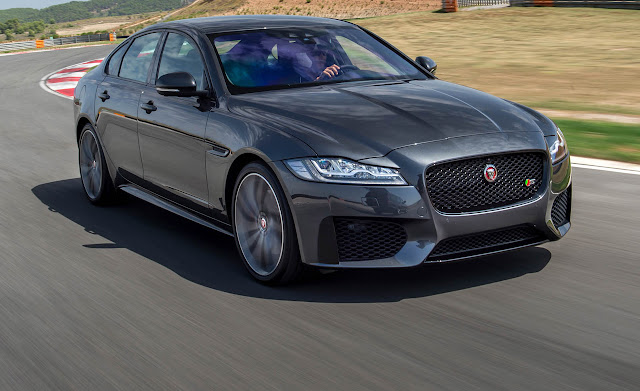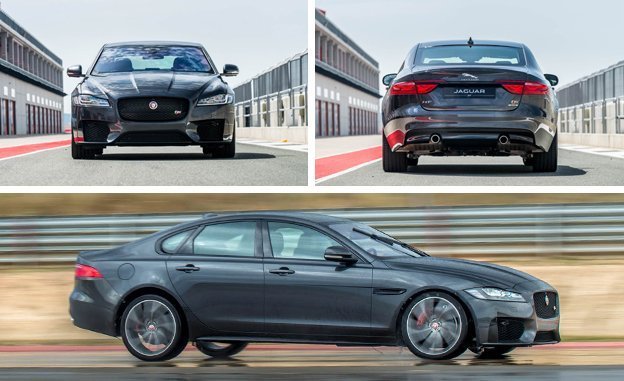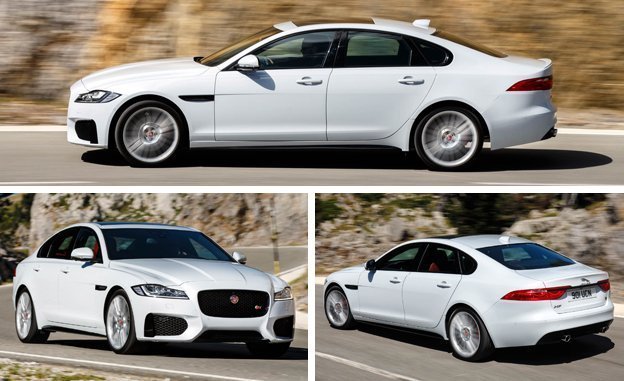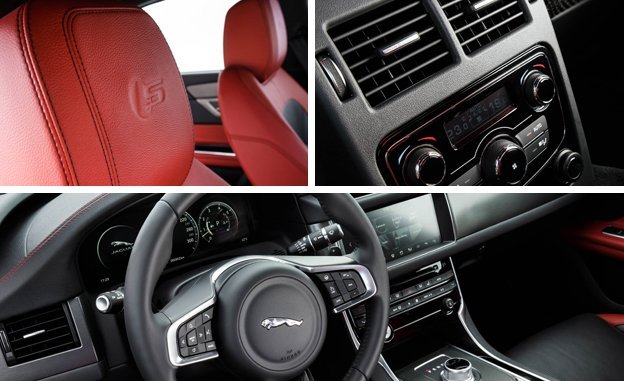When this Jaguar XF arrives in the States next year, no one will ask, “Is that the new Jag?” But the 2016 XF is entirely new, it just doesn’t look as new as it is. When the XFfirst debuted in late 2007, it broke Jaguar sedans away from the old-world aesthetic they’d been mining since the 1960s. Gone were the four round headlights, the lavish chrome, and the slavish devotion to the British firm’s heyday. It was the new Jaguar. We were so smitten by the XF’s design and dynamics that we put it on our 10Best list in 2009. As the first modern Jaguar you could drive without looking like you’d borrowed your great uncle’s car, its rejection of retro design made it possible for the rest of the Jaguar lineup to shake some of the design vestiges of the 1950s and ’60s. But as the XF enters its second generation, it has emerged looking a lot like its predecessor, which is now an old Jaguar.
Even if it doesn’t advance Jaguar design like its predecessor, the 2016 XF is still a damn good sequel. Its shape retains the aggression you expect of a brand named after a predatory cat. The XF isn’t likely to become the avatar of the gray-haired, but rather the gray-templed. Despite looking like the old XF, no sheetmetal is shared. “A few screws are all that we kept,” says Mike Bradley, senior launch manager. Put old and new next to each other and the new car’s nose appears more blunt, the side glass more upright, and the tail longer. The added length is simply a visual trick, though, as the XF is about the same size as before. The new platform offers two inches of extra wheelbase, but the car is a fraction of an inch shorter overall and lower. In the wind tunnel, the new car’s body is more slippery, boasting a claimed 0.26 Cd to the old car’s 0.29.
Aluminum Everywhere
Look underneath the bodywork, and it’s likely you’ll be eyeing a piece of aluminum. The XF’s aging Ford architecture that dated back to the Lincoln LS and the baroque Jaguar S-type is dead and buried. Aside from the doors, the trunklid, and the rear floorpan, the XF’s architecture is made up of bonded and riveted aluminum castings, extrusions, and stampings. The new platform is shared with the smaller XE, but according to Jaguar, only 20 percent of the XF is shared with the XE. What we find curious is that the doors and trunklid are steel. Saving weight by making door skins and trunklids out of aluminum is a relatively easy and obvious way to shave pounds. So why are the doors and trunklid steel? “It’s done to improve weight distribution,” says Bradley.
There is a bit more steel hidden away in the XF. For example, behind the stamped B-pillar is a high-strength-steel insert that bolsters rigidity and improves side-impact crashworthiness. A cast-magnesium crossbar hides behind the instrument panel and another cast-magnesium piece ties together the front structure. In all, the XF’s unibody is said to consist of 75 percent aluminum and be 28 percent more rigid. In all-wheel-drive V-6 guise, the car will weigh 265 pounds less than before, which would put it at about 4150 pounds. (The last supercharged AWD XF we weighed came in at 4385.)
Powering Up
When the XF goes on sale next year, the available engine will be the current XF’s 3.0-liter supercharged V-6. In base versions, the 60-degree V-6 again inhales from a twin-vortex supercharger, has its thirst slaked via direct fuel injection, and turns out 340 horsepower and 332 lb-ft of torque. This model, dubbed the XF 35t, will start at $52,895, a price drop of about $5000 from last year’s V-6 XF.
A 380-hp version of the same V-6 (as seen in the F-type) will be available, too. The extra power is due to zeros and ones and not any physical differences—the engine is mechanically identical to the 340-horse version. Jaguar didn’t reveal what the 380-hp option will cost in the 35t, but the sportier XF S with the higher-output six will start at $63,695. All-wheel drive will be optional. The rear-biased all-wheel-drive system is similar to its predecessor and can send power forward on demand, but the transfer case now has a chain drive instead of gears. Quiet operation is said to be the major advantage of the chain, but it’s also 16 percent lighter and 10 percent more efficient.
Moving Out
Over the road, the XF is quiet, even with the 2.0-liter turbo-diesel that Jaguar had us sample first. A cold start did make us think that it might be powered by a vibrating iPhone, but once warm and on the road its NVH lessened considerably. This diesel is part of Jaguar’s in-house-engineered Ingenium engine family. When the diesel arrives in the States in the middle of 2016, it will have 180 horsepower and 317 lb-ft of torque and may surpass 40 mpg on the highway. Jaguar hasn’t announced pricing for the diesel, but it did promise that it will start at less than $50,000.
We also experienced the supercharged V-6s that will go on sale first. We drove both rear- and all-wheel-drive versions in the 380-hp tune. Equipped with a balance shaft, the V-6 doesn’t make much noise, even as it spins right past its 6000-rpm redline and hits its governor near 7000 rpm. There’s a mellow rumble from the engine but no supercharger whine. The eight-speed automatic transmission snaps off shifts quickly and with ease. In Jaguar’s estimation, an all-wheel-drive 380-hp V-6 will run from zero to 60 mph in 5.0 seconds; we figure it’ll be a bit quicker. In our last test of a 340-hp 2015 XF with AWD, we managed a zero-to-60 time of 5.3 seconds. When asked about the possibility of V-8 versions, Jaguar reps smirked, but they aren’t ready to confirm anything.
Some of what the XF shares with the new XE is in the chassis. The independent rear suspension, made mostly of aluminum, comes from the XE. In front, the double wishbone is an adapted version of what’s in the F-type. Two suspension setups will be offered, a standard version with conventional shocks and an optional one with electronic shocks that can adjust damping on their own or via driver input. The roads in Spain where we sampled the cars are glassy smooth, the country apparently having spent its last Euro on road construction, so it’s difficult to judge the ride quality. On these roads the XF is taut but never harsh. Body control is excellent and the XF drives smaller and feels lighter than the German cars in its class.
The electric power steering comes across as light, but it imparts a sense of liveliness. While our European-market test cars were equipped with summer tires, American versions will get all-season rubber that likely will reduce grip and steering feel, but we’ll have to wait and see. It is theoretically possible to order summer tires for the XF, but Jaguar reps tell us it’ll be a special-order situation.
Inside the Shell
Like the exterior, the interior of the XF is a modernization of the themes established by its predecessor. The air vents still open like miniature garage doors; the gear selector is still a small dial that rises when you push the start button. In the center of the instrument panel is a large touch screen that features Jaguar’s latest infotainment system, InControl. On the standard version, phone, audio, and navigation functions, as well as the home screen, have a button for quick access. Once within the system though, there are no redundant controls, so you have to tap the screen to enter a point of interest into the navigation system or tune in a radio station. Response time is good, but it would take some getting used to before we were comfortable using it in traffic. Below the big touch screen are actual buttons that manage the climate-control system. We’d rather have volume and tuning knobs than HVAC buttons. Some audio functions can be controlled via the steering-wheel buttons, but we adjust the radio far more often than the climate control.
An InTouch Pro system with greater functionality will be optional. The Pro version features a larger screen that doesn’t have buttons, but the main screen can be personalized so that the functions you use most are immediately accessible. Opting for InTouch Pro also replaces the mechanical gauges in the cluster with a large configurable TFT screen that can display a large map from the navigation system, and it can show several different gauges that mimic mechanical gauges. Switch the car to Dynamic mode and the speedo and tachometer trade places, with the tach taking center stage.
In-car Wi-Fi will be available and the XF also will feature an app that allows the owner to monitor their car’s mileage, whereabouts, and fuel level. The app will also allow you to start the car, set the interior temperature, turn on the heated or cooled seats, and lock and unlock the doors. Tesla and other manufacturers have offered these capabilities for a couple of years, but they’re new to Jaguar.
Without a formal comparison test, and without driving the finalized U.S. version, we’re not quite ready to lock in the XF’s position in the mid-size luxury-sedan segment. But we can say that the new XF feels more lithe, involving, and playful than the usual suspects from Germany (the Audi A6, BMW 5-series, and the Mercedes-Benz E-class). While it isn’t as aggressive as the sports-car-aping Cadillac CTS Vsport, and its primary controls lack the dogged alertness of the Cadillac’s, it’s not far off. It does have a more pleasing interior than the CTS, and the Jag's supercharged V-6 is smoother than, if not as powerful as, the American car’s twin-turbo six. But this is just the first version of the new XF. Sportier and more powerful versions are undoubtedly on the drawing board.
For other Jaguar's car's you can find it jaguar.












0 commentaires:
Enregistrer un commentaire